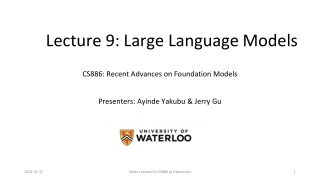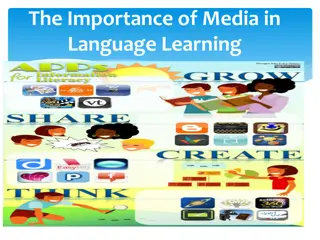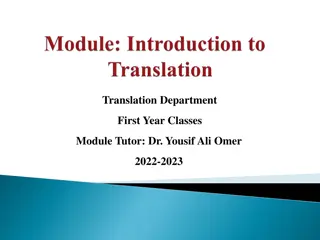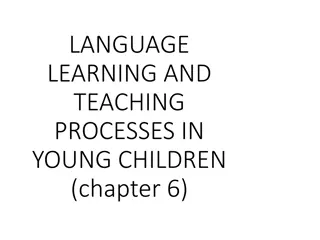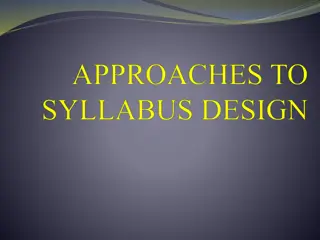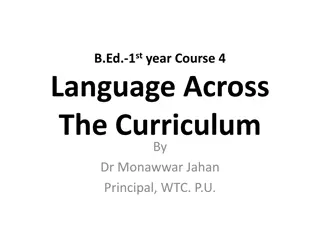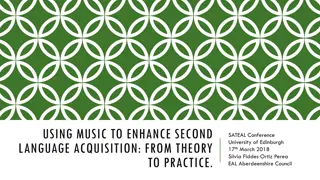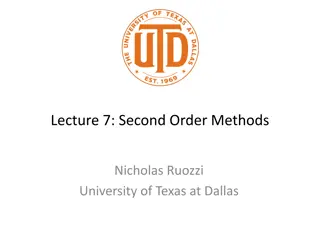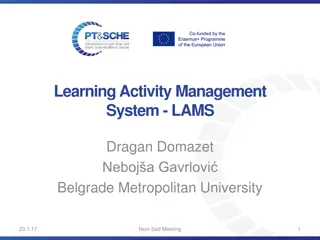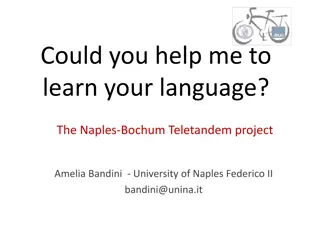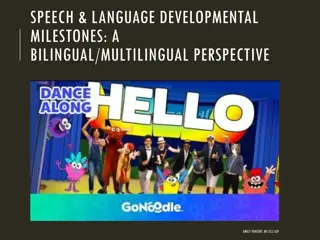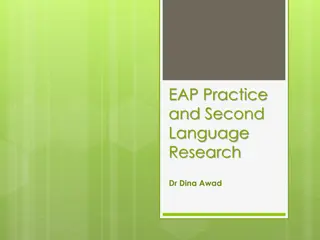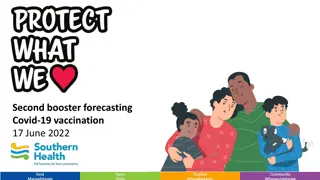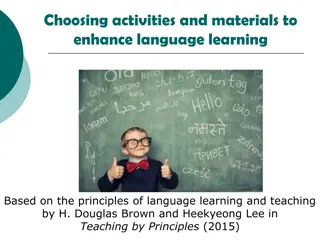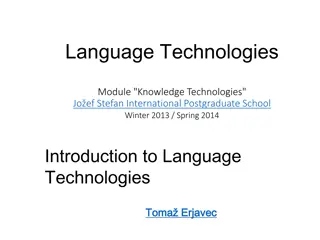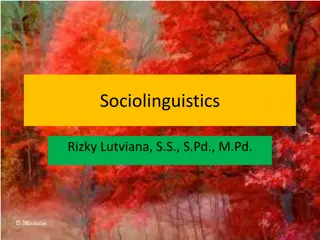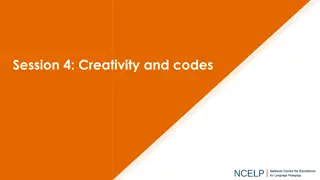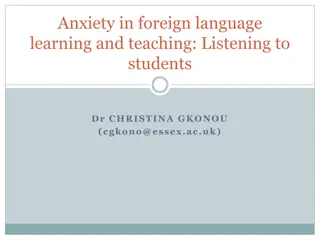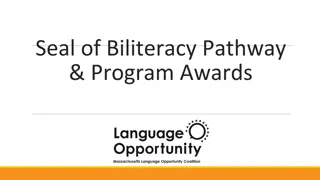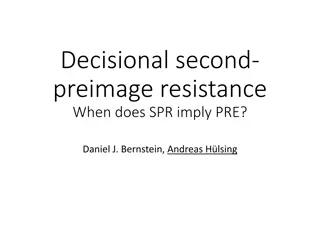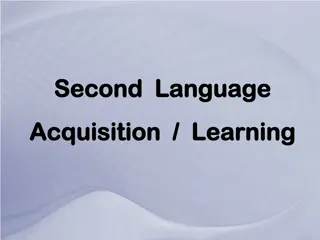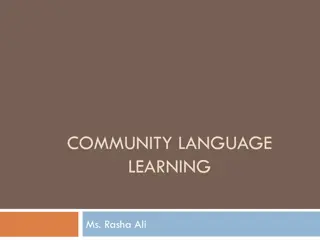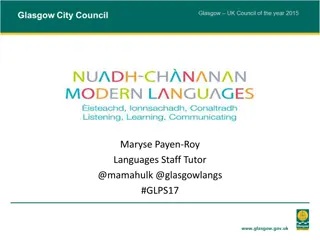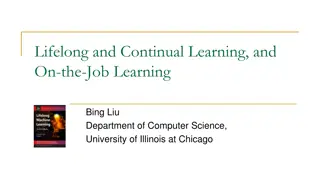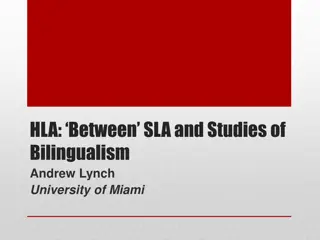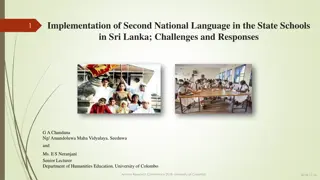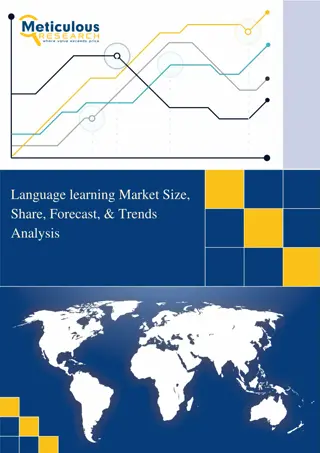Community Language Learning
Community Language Learning (CLL) involves collaborative language learning where teachers act as counselors and learners work together. CLL teachers aim to teach communicative language skills, foster self-learning, and mutual learning among students through valuing thoughts and feelings. Popular
3 views • 14 slides
Career Opportunities and Challenges in Translation & Interpreting Pedagogy Post-Pandemic
The APTIS 2022 conference explores new avenues in Translation and Interpreting (T&I) pedagogy amidst a changing landscape. Dr. Bego A. Rodriguez highlights emerging roles for T&I graduates. The context reveals a decline in language learning in the UK, impacting the Language Service Industry. The UK'
1 views • 13 slides
Recent Advances in Large Language Models: A Comprehensive Overview
Large Language Models (LLMs) are sophisticated deep learning algorithms capable of understanding and generating human language. These models, trained on massive datasets, excel at various natural language processing tasks such as sentiment analysis, text classification, natural language inference, s
3 views • 83 slides
Language Study Community – Enhance Your Language Skills
Joining a Language Study Group is a fantastic way to take your language learning to the next level. By leveraging the power of Group Study, you can immerse yourself in the language, enhance your understanding, and build confidence in your speaking abilities. Read full article \/\/explainlearning.com
1 views • 3 slides
Academic Language Demands and Supports in Instructional Planning
Academic Language Demands and Supports are crucial in educational settings to ensure comprehension and usage of language by students. This content discusses embedding language demands in lesson plans, providing language supports, and peer review activities to enhance academic language skills. The fo
6 views • 10 slides
The Significance of Media in Language Learning
Media plays a crucial role in language learning by raising awareness of the ideology behind linguistic structures and providing valuable information on society and culture. Linguists are drawn to media language for research purposes and to understand its impact on language use and attitudes. Media s
12 views • 5 slides
Translation: Key Concepts and Definitions
Translation involves transferring written text from one language to another, while interpreting deals with oral communication. Etymologically, the term "translation" comes from Latin meaning "to carry over." It is a process of replacing an original text with another in a different language. Translat
12 views • 76 slides
Second Opinion On Cancer Treatment-Second Chance In Life- Dr. Manoj Dongare
Did you know that seeking a second opinion from an experienced cancer specialist in Pune could be the key to unlocking more effective cancer treatment options? When you are diagnosed with cancer and researching about the treatment options then you must take a second opinion for your treatment for be
1 views • 3 slides
Second Marriage Matrimony A Comprehensive Guide
Discover a new beginning with our Second Marriage Matrimony website. Connect with like-minded individuals who understand the beauty of second chances. Looking for love after divorce? Our Second Marriage Matrimony website is here to help you find your soulmate. Begin another part of your life today.
1 views • 1 slides
Discovering Happiness in Second Marriage Matrimony
Find your perfect match for a second chance at love. Join our Second Marriage Matrimony website and discover a world of happiness and companionship. Start your journey today. Looking for a partner for your second innings? Explore our Second Marriage Matrimony website and connect with like-minded ind
0 views • 1 slides
Love and Responsibility in Second Marriage Matrimony
Second marriages bring a unique blend of love and responsibility, offering a fresh start while building on past experiences. In second-marriage matrimony, individuals often find a deeper appreciation for companionship and mutual respect. Love is nurtured through shared understanding and the wisdom g
3 views • 1 slides
Language Learning and Teaching Processes in Young Children
Development of language in young children is influenced by various factors such as their cultural and linguistic environment, unique characteristics, and interactions with adults. Optimal language development requires language stimulation from the environment. Varied cultural practices impact langua
1 views • 51 slides
Language Teaching Syllabus: Integration, Theory, and Approaches
Language Teaching Syllabus involves the integration of subject matter and linguistic elements, guided by theories of language and learning. Various approaches like Grammatical, Situational, Communicative, and Analytic are used to structure syllabi. Breaking language into parts aids in sequential lea
1 views • 28 slides
Language and Communication Through a Short Film
In this lesson, students will watch a 10-minute short film titled "The Most Beautiful Thing" by Cameron Covell. They will reflect on the value of learning another language, analyze how facial expressions and body language convey emotions, and develop empathy towards those facing language barriers or
1 views • 29 slides
Enhancing Language Learning Across the Curriculum in B.Ed. 1st Year Course
Language Across the Curriculum (LAC) emphasizes that language learning should occur across all subjects, not just in language classrooms. It highlights the importance of incorporating language development into every learning activity, fostering multilingualism in schools. Language plays a crucial ro
3 views • 34 slides
The Power of Music in Second Language Acquisition
Enhancing second language acquisition through music offers numerous benefits such as improved pronunciation, vocabulary expansion, cultural understanding, and enhanced motivation. Music activates brain regions vital for learning and memory, releases dopamine to improve mood, and provides a portable
0 views • 27 slides
Optimization Methods: Understanding Gradient Descent and Second Order Techniques
This content delves into the concepts of gradient descent and second-order methods in optimization. Gradient descent is a first-order method utilizing the first-order Taylor expansion, while second-order methods consider the first three terms of the multivariate Taylor series. Second-order methods l
1 views • 44 slides
Exploring Unusual Activities and Second Conditional Grammar
Delve into the realm of unusual activities and learn about the second conditional grammar in this engaging study. Discover vocabulary related to hypnotism, hair dyeing, and tarantulas. Explore how the second conditional is used to discuss improbable future scenarios and present impossibilities. Unde
1 views • 9 slides
Innovative Learning Management System - LAMS at Belgrade Metropolitan University
Belgrade Metropolitan University (BMU) utilizes the Learning Activity Management System (LAMS) to enhance the learning process by integrating learning objects with various activities. This system allows for complex learning processes, mixing learning objects with LAMS activities effectively. The pro
4 views • 16 slides
Early Childhood Language Learning and Bilingualism
Early childhood is a critical period for language acquisition and the development of bilingualism. Exposure to multiple languages from a young age has significant cognitive benefits. Bilingualism is a common phenomenon worldwide, with many individuals speaking more than one language. The cognitive i
0 views • 109 slides
Enriching Language Learning with Teletandem Activities: A Blended Approach
The Naples-Bochum Teletandem project led by Amelia Bandini at the University of Naples Federico II focuses on enhancing German language courses through a blended learning approach. The project aims to combine formal instruction with informal language learning environments to enrich students' cultura
3 views • 27 slides
Speech and Language Developmental Milestones: A Bilingual/Multilingual Perspective
Speech and language developmental milestones are crucial for children, regardless of their home language. These milestones encompass receptive language, expressive language, pragmatics, and articulation and phonology. Understanding how a child hears and talks from birth to one year is essential, as
1 views • 23 slides
Insights into Second Language Learning Research
This presentation delves into various aspects of second language learning research, including the use of dictionaries, part-of-speech explanation, grammatical rules, and bilingual dictionary use. Studies show mixed results on the effectiveness of meta-analysis in form-focused instruction and the imp
0 views • 26 slides
COVID-19 Second Booster Forecasting Webinar Summary November 2021
The webinar discussed the proposed cohorts eligible for the COVID-19 second booster, including individuals aged 65+, Māori and Pacific peoples aged 50+, residents of aged care and disability facilities, severely immunocompromised individuals, and more. New legislation is expected by end-June, with
0 views • 25 slides
Enhancing Language Learning through Effective Classroom Practices
Explore the principles of language learning and teaching by Brown and Lee in "Teaching by Principles" (2015). Discover how automaticity, transfer, and task design impact language acquisition in the classroom. Emphasize meaningful interactions, purposeful tasks, and the balance between controlled and
0 views • 33 slides
Introduction to Language Technologies at Jožef Stefan International Postgraduate School
This module on Knowledge Technologies at Jožef Stefan International Postgraduate School explores various aspects of Language Technologies, including Computational Linguistics, Natural Language Processing, and Human Language Technologies. The course covers computer processing of natural language, ap
0 views • 27 slides
Sociolinguistics: Language Variation and Social Factors
Sociolinguistics delves into the study of language variation influenced by social factors, examining the relationship between language and its social context. It explores various aspects like standard pronunciation, language choice, speech acts, language components, language variety, and factors suc
0 views • 73 slides
Assembly Language Programming for Computing Layers
Assembly language is a low-level programming language that enables direct interaction with a computer's hardware components. This content explores the fundamentals of assembly language, the relationship between human-readable machine language and binary code, an assembly language program for multipl
1 views • 31 slides
Unleashing Creativity through Language Learning and Code-Breaking
Language learning has a profound impact on creativity, with a strong correlation between proficiency in a second language and creative flexibility, fluency, and originality. Delve into the realm of code-breaking linguists and discover the cognitive benefits of bilingualism. Explore a career in the R
0 views • 17 slides
Language Anxiety in Foreign Language Learning and Teaching
Explore the impact of language anxiety on students and teachers in foreign language learning and teaching contexts through insights from Dr. Christina Gkonou's research. Delve into the theoretical background, implications for language education, and real-life experiences shared at the Essex Language
0 views • 25 slides
The Value of Learning a Second Language and Career Opportunities
Exploring the significance of studying a second language, the benefits of being multilingual in the global marketplace, language choices at Willowmoore High School, considerations when choosing between Afrikaans and isiZulu, and the various career paths that revolve around language skills and profic
0 views • 7 slides
Benefits of the Seal of Biliteracy and Learning a Second Language
The Seal of Biliteracy recognizes students proficient in multiple languages, promoting global competence, cognitive benefits, and employability. Learning a second language fosters critical thinking, cultural understanding, and opens doors to diverse opportunities in the increasingly interconnected w
0 views • 27 slides
The Relationship between Decisional Second-Preimage Resistance and Preimage Resistance in Cryptographic Hash Functions
This work delves into the subtle question of when Decisional Second-Preimage Resistance (SPR) implies Preimage Resistance (PRE) in hash functions. It presents a tool for enabling tight security proofs for hash-based signatures by exploring the success probability of adversaries against collision res
0 views • 25 slides
Insights into Second Language Acquisition and Learning
Understanding the processes of second language acquisition and learning, including the differences between unconscious acquisition and conscious learning, barriers encountered, impact of early experience and age, affective factors like self-consciousness, and teaching methods like the Grammar-Transl
1 views • 23 slides
Effective Community Language Learning Method by Ms. Rasha Ali
Community Language Learning (CLL) method emphasizes understanding students' feelings and creating a supportive environment for language learning. This approach, influenced by the Counseling-Learning approach, focuses on building relationships, reducing anxiety, and promoting effective communication
1 views • 15 slides
The Role of Play in Language Learning and the Critical Age Theory
The critical age theory suggests that young children have greater brain plasticity for language internalization, while adults can learn L2 faster due to developmental stages. Learning a second language early provides advantages in accent acquisition. Affective relationships and play are crucial in l
0 views • 15 slides
Lifelong and Continual Learning in Machine Learning
Classic machine learning has limitations such as isolated single-task learning and closed-world assumptions. Lifelong machine learning aims to overcome these limitations by enabling models to continuously learn and adapt to new data. This is crucial for dynamic environments like chatbots and self-dr
1 views • 32 slides
Contrasting Heritage Language Acquisition and Second Language Acquisition
Heritage Language Acquisition (HLA) and Second Language Acquisition (SLA) differ in various aspects including context of acquisition, age of acquisition, degree of proficiency, and identity. HLA typically begins at home, while SLA often starts in a classroom setting. Factors such as naturalistic vs
1 views • 24 slides
Implementation of Second National Language in State Schools in Sri Lanka: Challenges and Responses
Sri Lanka, a multi-ethnic country with Sinhala, Tamil, and English as prominent languages, has faced challenges due to lack of understanding between language-speaking groups. The introduction of a Second National Language (2NL) in schools aims to promote reconciliation and understanding. This study
0 views • 10 slides
language learning market 3 (1)
The growth of the language learning market is driven by globalization and the growing need for cross-border communication, minimal platform price of language learning applications, and increasing adoption of artificial intelligence (AI) in e-learning. Furthermore, the growing preference for multilin
0 views • 5 slides


